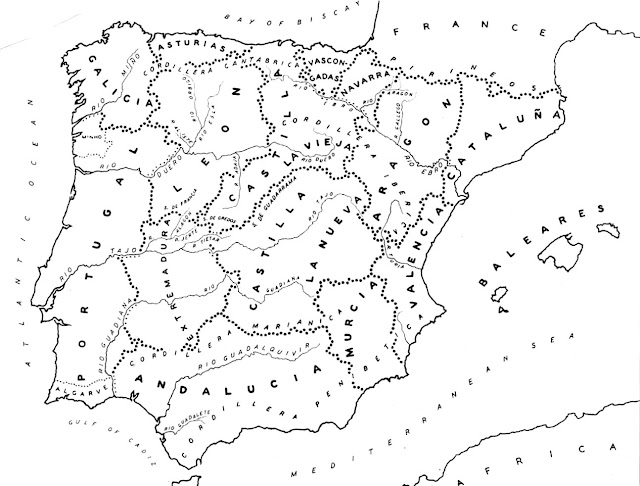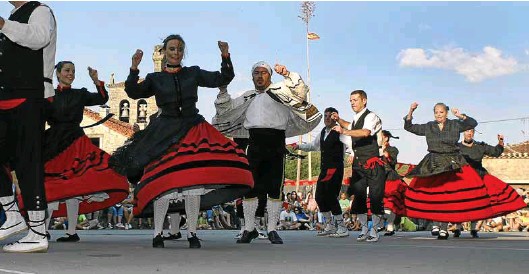Today I am going to attempt to give an overview of the Folk Costumes of Spain. Spain is a multilingual and multiethnic State; several distinct languages are spoken, four of which are officially recognized by the State. The image above shows the flags of the traditional regions of Spain, many of which were formerly kingdoms. They are for the most part coterminous with the modern 'Autonomous Communities' Here is a map of the traditional regions followed by one of the current Autonomous Communities, which also shows the provinces into which they are divided.

The main difference is that Castile has been split into three regions; New Castile, which is called 'Castile La Mancha', the city of Madrid, and Old Castile, which has been lumped together with Leon as 'Castile Leon'. Here is a map showing the names of all of the Provinces.

I will proceed region by region, and province by province where appropriate.
Galicia
Galicia has its own federally recognized language, and is quite different in character from the rest of Spain, being mainly of Celtic blood. The language is much closer to Portuguese than to Castillian Spanish
https://www.youtube.com/watch?v=ZDrll-JPOBo
It is currently divided into four Provinces: Ourense, Lugo, A Coruña, and Pontevedra. I have not been able to discern any distinction in the local costumes, they seem to all be of the same tradition.
Galician costumes are distinguished by a great deal of beadwork in jet, which is locally available. The costume tradition is rich and very elegant.
Pontevedra
Lugo
A Coruña
Ourense
Here is a video of a dance group from Galicia, doing first a Jota, and then what looks a lot like a jig. Very Celtic in both sound and appearance.
More images of Galego Costume
A piece by piece explanation of Galician Costume. I am not sure if it is in Galego or Castillian.
https://www.youtube.com/watch?v=VwFYRiEEr8MAsturias
The Asturians have many cultural similarities to the Galicians, also being partly of Celtic origin. In the western edge of Asturias, Galego is spoken, in the rest, the Asturian language, which has some legal protection, but is not recognized by the federal government. Castillian is the official language of Asturias. Asturias is mountainous, and because of its proximity to the ocean, it is moist and green. It is composed of one province only.
A dance from Asturias
https://www.youtube.com/watch?v=9djhSeJNLaYCantabria
Cantabria is also part of Spain's green zone, being along the Atlantic coast. Some indigenous dialects are still spoken in the western part, but have no legal recognition. The eastern part has long been Castillian speaking.
A dance from Cantabria.
https://www.youtube.com/watch?v=xwDuswIlh8k
Euskal Herria - Basque Country
The Basque people have their own very distinctive language, which is one of the four Federally recognized languages of Spain. It is without doubt that the Basque language had an influence on the development of Castillian, and was once more widely spoken than it is today. It is completely unrelated to the other languages of Spain, and predated the Latin language in Iberia.https://en.wikipedia.org/wiki/Basque_Country_(autonomous_community)
Although the Basque people have preserved very strongly many aspects of their culture, from cuisine to language to sports, even dance and music, they have not kept, or perhaps never developed a distinctive folk costume, except for the famous beret. The majority of images of Basque costume show very plain work costumes, or ritual costumes. The Basque country of Spain, as small as it is, is divided into three provinces, Bizkaia, Araba, and Gipuzkoa. The Basques also inhabit the north part of Navarre and adjacent regions in France. Here are some images which I have found.
Basque men dancing.
https://www.youtube.com/watch?v=bce4f2FI5Aw
Mixed Basque dance
https://www.youtube.com/watch?v=bce4f2FI5Aw
Navarre
Navarre has a very long history as a separate kingdom. It was founded by the tribe Vascones, but later grew to the south and attracted many Romance speaking settlers. There was a native Romance dialect related to Aragonese, but this has died out. At present, the north of Navarre is Basque speaking, the south is Castillian speaking, and the center is mixed. Navarre forms only one province.https://en.wikipedia.org/wiki/Navarre
The best known and preserved costume of Navarre is that of Roncal in the northeast. This was originally a Basque speaking area, as is preserved in the names of the costume pieces.
Salazar
Baztan
Jota from Navarre
https://www.youtube.com/watch?v=ERUwTwBRxU0
Parade in Navarre
https://www.youtube.com/watch?v=PVmrjD__P48
La Rioja
HIstorically this area was disputed and held at various times by Navarre, Aragon, Castille, and the Basques. Today it is completely Castillian speaking, but was designated a separate Autonomous Community by the government of Spain. It forms a single province. It used to be known as Logroño.https://en.wikipedia.org/wiki/La_Rioja_(Spain)
https://www.youtube.com/watch?v=i8nAS41ZgW0
Here is a ritual dance from this region, done on the feast of St Mary Magdalene in the village of Anguiano. It features boys in skirts and on stilts dancing in the streets. This outfit is only worn for this festival. There are many such traditions around Spain.
https://www.youtube.com/watch?v=37SlKBxuPwg
Aragon
Aragon was one of the major kingdoms which made up Spain in the course of history. Like Castille and Leon, it made territorial advances to the south during the reconquest of Spain from the Moors. The Aragonese language was similar to that of southern Navarre, which is now extinct, and survives only in the northern mountains of Aragon. In the east there is a narrow strip of territory in which Catalan is spoken. In the center and south of the region, only Castillian is spoken today.Aragon
https://en.wikipedia.org/wiki/Aragon
Aragon is made up of three provinces, Huesca, Zaragoza, and Teruel, from north to south.
Huesca
The most famous costume in Huesca is that of Anso, which lies just over a ridge of mountains from Roncal.
A dance from Anso
https://www.youtube.com/watch?v=_GWVr172qmU
Zaragoza
There are country and city versions of this costume, distinguished by the materials used.
A website where they make Zaragozan costume.
http://www.trajesregionaleslou.es/confeccion-de-trajes-regionales.html
A dance from Zaragoza
https://www.youtube.com/watch?v=01H6OcQuXoo
Teruel
A dance from Albarracin in Teruel.
https://www.youtube.com/watch?v=M37ybsBHt28
Leon
Leon is one of the original kingdoms which made up Spain. It later became somewhat eclipsed by Castille. Today it has been merged with the northern part of Castille to form the Autonomous Community of Castille-Leon. The Leonese language has affinities with Asturian, and likewise has no legal recognition. It has mostly become replaced by Castillian.
The region of Leon is divided into the provinces of Leon, Zamora and Salamanca, from north to south.
Leon
Festival and dancing in the province of Leon.
Zamora
Aliste
Carbajales de Alba
A dance from Carbajales de Alba in Zamora. There is a rather annoying introduction.
Salamanca
La Alberca
Calendario
Charro
A dance of the Charro of Salamanca.
Old Castile - Castilla la Vieja
https://en.wikipedia.org/wiki/Old_Castile
Today Old Castile is considered to include the provinces of Burgos, Soria, Segovia, Avila, Palencia and Valladolid.
Burgos
Dances from Burgos.
https://www.youtube.com/watch?v=fNX-vIIT5_I
https://www.youtube.com/watch?v=ETWEHQRbmvs
https://www.youtube.com/watch?v=ETWEHQRbmvs
Soria
Dances from Soria.
https://www.youtube.com/watch?v=d24PnkaWuvw
Palencia
Dance from Palencia.
https://www.youtube.com/watch?v=oKLLd2zNYD0
Valladolid
Segovia
Street dance in Segovia. The last couple is in full Segovian dress, the next girl in the yellow skirt is in Avila costume. The rest in some sort of dance group costume.
https://www.youtube.com/watch?v=FoHilmVrch8
Dance from Segovia.
https://www.youtube.com/watch?v=Fr4S74y3wzc
Avila
TV story about a performing group from Avila.
https://www.youtube.com/watch?v=chy7_osajKY
Group from Avila dancing in a simpler costume.
https://www.youtube.com/watch?v=6dYA_pGPMZg
This is enough for one article. I will continue the southern part of Spain in my next article.
Thank you for reading. I hope that you have found this to be interesting and informative.
Roman K.
email:rkozakand@aol.com





























































































































